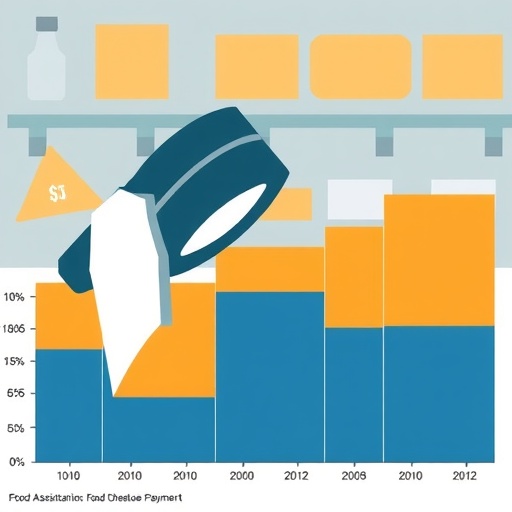A groundbreaking recent study published in the journal Contemporary Economic Policy unveils a compelling link between the timing of food assistance payments and crime rates in the United States. Drawing on more than ten years of comprehensive data from 36 states, the research scrutinizes how the distribution schedule of Supplemental Nutrition Assistance Program (SNAP) benefits influences the incidence of financially motivated crimes, with a particular focus on robberies. This analysis opens a transformative dialogue around public policy design and its ripple effects on community safety and economic behavior.
The research centers on the comparison between traditional lump-sum, single-day monthly disbursements of SNAP benefits and a staggered distribution schedule extending over 15 or more days each month. The authors found that spreading out benefit payments leads to a subtle yet statistically significant reduction in robbery rates. Specifically, the research shows a decrease of 0.03 robbery incidents per 100,000 residents correlated with the more extended disbursement schedule. Though this numerical figure might seem modest at a glance, the aggregate national impact is profound when extrapolated across the scale of the entire United States.
Intriguingly, this study addresses a critical issue known in criminology and economics as the “benefit cycle” effect. Traditionally, the infusion of large sums into recipients’ accounts at once has been associated with spikes in crime, particularly property and financial crimes, as offenders exploit the sudden influx of resources. The research presented challenges and refines this understanding by showing that modifying payment timing can effectively smooth consumption patterns, reduce acute financial pressures, and thereby mitigate crime outbreaks.
The technical methodology involved in this study is robust, leveraging longitudinal crime data and SNAP distribution records over more than a decade. The researchers applied econometric modeling techniques to isolate the effect of payment timing from other variables influencing crime rates, such as overall economic conditions, seasonal trends, and law enforcement policies. This methodological rigor ensures that the findings point to a causal relationship rather than mere correlation.
From a policy perspective, the implications are profound. The staggered disbursement model entails no additional cost to the program’s administration; it simply rearranges when benefits are paid out. According to lead author Licheng Xu, PhD, this “nearly free” modification has the potential to yield both social and economic dividends by reducing the human and financial toll of crime. Urban areas, often hardest hit by crime linked to economic deprivation, could see meaningful improvements in public safety without increased law enforcement expenditures.
Further, the economic benefit quantified in the study is striking. The authors estimate that extending the SNAP disbursement schedule could result in an annual reduction of approximately $2.7 million in crime-related costs nationwide. These cost savings encompass not only direct losses from robberies but also secondary expenditures on police resources, judicial processing, and incarceration. The research thereby positions SNAP policy reform as an effective indirect crime prevention strategy with measurable economic returns.
The study also contributes to the broader discourse on income inequality and food security. By smoothing benefit payments, recipients can experience enhanced financial stability, which may reduce the desperation and stress that often precipitate criminal activity. Improved food security and reduced poverty-induced strain underscore the broader social benefits layered into this seemingly straightforward policy adjustment.
Highlighting the interdisciplinary nature of the research, findings resonate across fields including agricultural economics, criminology, public policy, and social welfare studies. It underscores the complex interplay between social safety net programs and their unintended consequences. Researchers suggest that extending the concept beyond SNAP to other forms of government assistance programs might reveal additional opportunities to mitigate financial stress-driven behaviors.
In addition to the primary outcomes related to crime reduction, the staggered distribution model may encourage better financial planning and consumption smoothing among beneficiaries, enhancing their overall economic well-being. Such behavioral changes have been well-documented in the literature on cash transfer timing, reinforcing that payment frequency can influence spending patterns and subsequently social outcomes.
The study’s cross-state approach enhances its generalizability, demonstrating consistent effects across diverse American populations, urban and rural, with varying demographic profiles. This geographic breadth alleviates concerns about localized or population-specific anomalies influencing results, boosting confidence in policy recommendations drawn from the research.
Moreover, this research sets a precedent for future inquiries that explore how the timing and structure of social programs influence secondary societal effects such as crime, economic activity, and social cohesion. It challenges policymakers and economists to take a holistic view, considering dynamic behavioral responses and unintended consequences in the design and implementation of welfare initiatives.
Taken together, this study adds a nuanced layer to our understanding of how public assistance programs shape not only economic outcomes but also public safety. The evidence favors a recalibration of SNAP distribution schedules as a cost-effective, empirically grounded measure to foster safer communities across the nation.
This innovative contribution by researchers at institutions including Beijing Normal University and the University of Wisconsin-Madison represents a significant step forward in aligning social welfare programs with broader societal goals. The integration of economic insights and criminological data exemplifies the power of interdisciplinary research to inform smarter, evidence-based public policy reforms.
Subject of Research: The impact of Supplemental Nutrition Assistance Program (SNAP) disbursement timing on financially motivated crime rates, particularly robbery, in the United States.
Article Title: Timing of SNAP disbursement and crime incidence in the United States
News Publication Date: 6-Aug-2025
Web References:
- Journal: Contemporary Economic Policy
- DOI: 10.1111/coep.70005
References: Available upon request from the publisher.
Keywords: Food security, Crime, Public policy, Income inequality, United States population




